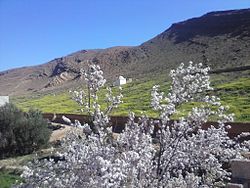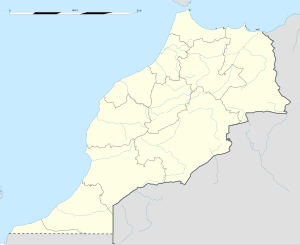Ifrane Atlas-Saghir or Ifrane, Anti-Atlas (Arabic: إفران الأطلس الصغير, meaning cave), is a village and commune in southern Morocco populated by some 12,000 inhabitants.[1] The town, its arid valley, oasis and surrounding mountains attract some tourism, from hikers and Jewish pilgrims. Ifrane Atlas-Saghir was also known by the former local Jewish community as Oufrane.
Ifrane Atlas-Saghir
Ifrane, Anti-Atlas Oufrane | |
|---|---|
Village and rural commune | |
 | |
| Coordinates: 29°12′38.2″N 9°29′34.35″W / 29.210611°N 9.4928750°W | |
| Country | |
| Region | Guelmim-Oued Noun |
| Province | Guelmim |
| Population (2004) | |
| • Total | 11,950[1] |
| Time zone | UTC+0 (WET) |
| • Summer (DST) | UTC+1 (WEST) |
History
editIfrane Atlas-Saghir was an important trading post and market for the caravan trade moving across the Sahara to the sea-coast, until the trade faded away in the late 1800s. The area is now populated by the Chleuh (Amazighen Berbers) group, who today generally maintain their traditional way of life.
Jewish community
editIfrane Atlas-Saghir was an ancient home to a 2,000-year-old Jewish population, the oldest in Morocco, until 1958 when they left as a group to settle in Israel.[2] Today an important Jewish pilgrimage site is located there, being the site of a mass suicide of the 1700s, undertaken in the face of a brutal persecution by a local sorcerer. The remains of Jewish cemeteries are also known today... "in the gorges of the Oufrane, there are ancient cemeteries with headstones that have inscriptions in Hebrew."[3] The descendants of Maklouf have maintained an oral history of their family's fate following the massacre, which their great-great-great-great grandmother managed to escape.[4] Due to the importance of Ifrane's Jewish heritage, a synagogue has been restored in the abandoned mellah there, by the Foundation for Jewish-Moroccan Cultural Heritage. The district's long-standing Jewish culture has left another lasting legacy, in the form of the continuing observance of some aspects of Jewish folklore among the local Berbers.
Notable people
editSee also
editReferences
edit- ^ a b "Recensement général de la population et de l'habitat 2004". Haut Commissariat au Plan. Archived from the original on 19 June 2018. Retrieved 15 June 2012.
- ^ Nabil Boudraa, Joseph Krause (eds.), North African Mosaic: A Cultural Reappraisal of Ethnic and Religious Minorities, Cambridge Scholars, 2007, p. 166.
- ^ Sacheverell Sitwell, Mauretania: warrior, man, and woman, 1940, p. 121.
- ^ Knafo, Saki (January 19, 2023). "On a Family Journey to Morocco's Southern Coast, a Writer Reckons with His Homeland's Religious History". Conde Nast Traveler (January/February 2023). Archived from the original on 23 January 2023. Retrieved 29 January 2023.
{{cite journal}}: CS1 maint: bot: original URL status unknown (link)
29°12′38.2″N 9°29′34.35″W / 29.210611°N 9.4928750°W
